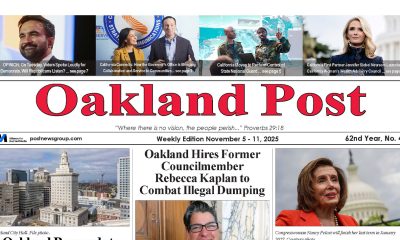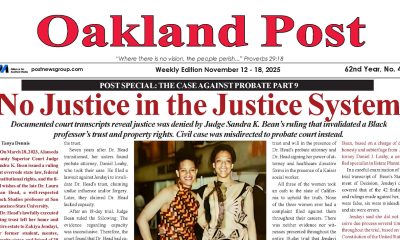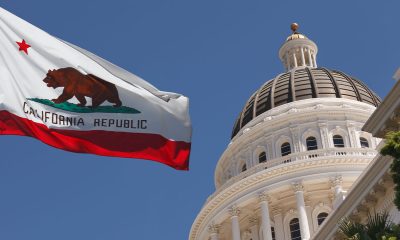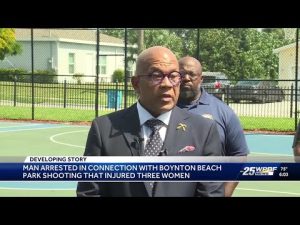Community
A Tragic Death, Health Fears Add to Concern Over California New Extreme-Heat Reality
A Riverside County family is grieving — and a local community is stunned — after a 12-year-old boy suffered a fatal medical emergency during an excessive heat wave last week in Lake Elsinore.

By Mark Hedin, Lila Brown and Edward Henderson
A Riverside County family is grieving — and a local community is stunned — after a 12-year-old boy suffered a fatal medical emergency during an excessive heat wave last week in Lake Elsinore.
On Aug. 29, Yahushua Robinson, a student at Lake Canyon Middle School, allegedly did not “dress out” appropriately for gym class and was consequently punished by running laps in his street clothes.
His aunt told NBC4 Los Angeles that he was denied a water break by his physical education teacher. His classmates reported that Robinson repeatedly complained of difficulty breathing before collapsing and becoming unresponsive.
Despite the efforts of medical professionals, Robinson was pronounced dead at Loma Linda University Medical Center-Murrieta.
The coroner’s report attributed Robinson’s death to cardiac arrest.
On the day of the incident, temperatures reached a high of 106° F. The California Department of Education advises schools throughout the state to assess whether outdoor activities, such as physical education and sports, should continue under such conditions.
However, it is still being investigated whether the proper protocol was followed. At 11 a.m., Riverside County Sheriff’s deputies were called to the school.
“Our hearts are with the family, friends, and our school community,” said Lake Canyon Middle School Principal Gil Rodriquez.
The family has since started a GoFundMe page (https://www.gofundme.com/f/yahshua-yaya-robinson) to raise money for funeral costs and other related expenses for the child they affectionately called “YaYa.”

Yahushua Robinson
Around the state, there is a growing concern among Black Californians about how extreme heat could affect elderly family members, impact skin care and exacerbate other health concerns.
Authorities have warned that sweltering temperatures will now be a part of life in the Golden State.
Worldwide, July was the hottest month on record, and the California Governor’s office reports that 2023 is “shaping up” to be the hottest year on record.
During an Aug. 29 press briefing hosted by Ethnic Media Services (EMS) and California’s Office of Community Partnerships and Strategic Communications, speakers discussed what’s changed and what can be done to adapt to this new reality.
“These are not your grandmothers’ heat waves,” said Braden Kay, Extreme Heat and Community Resilience Program manager for California’s Governor’s Office of Planning and Research.
“We have a critical need to support behavior change and mind-shift for a lot of people who feel their bodies should just be able to handle the heat, but are not,” Kay continued. “Not just today, not just this summer, not just next summer, but for decades to come.”
According to Kay, “Extreme heat is a climate risk that all 58 counties in California will face,” noting that 90-degree weather now sometimes occurs as early as March and as late as November.
Sara Gardner, a massage therapist in San Diego, said skin care is extremely important during heat waves and everyone should wear sunscreen to protect their skin from dangerous sun rays.
“When it’s hot and dry out, I’ve have found exfoliating and moisturizer to be a must every day. I like to use ice each morning directly on my skin to help close my pores which helps me make sure I don’t let out as much sweat and buildup throughout the day. I also like to lock in my moisture with a cream, typically something with Vitamin C.
Experts who participated in the EMS news briefing said Black Californians, Indigenous communities and other people of color are the most affected by health disparities worsened by extreme heat and are at a higher risk of heat-related deaths.
“As doctors, perhaps one of the most useful things we can do is educate the public,” said Sharon Okonkwo-Holmes, a doctor of family medicine at Kaiser Permanente Southern California.
“Older adults in general don’t feel as thirsty, but I’m telling them, ‘Stay on top of your hydration. Add lime, lemon, cucumber, whatever’s necessary to make you have an incentive for drinking.’”
To combat the extreme heat, California is making historic investments in climate action and public awareness. The state has launched a website at heatreadyca.com.
“It is an “all-of-state-government approach” to the challenge, Kay said. The site offers a new grant program to support awareness campaigns and add trees and shade infrastructure.
Last week, the Governor’s Office of Emergency of Emergency Services (CalOES) released a number of online toolkits (in 12 languages) to inform state residents about extreme heat and natural disasters.
Symptoms of heat exhaustion include feeling fatigued and tired, said Okonkwo-Holmes. Swelling in the lower extremities and high blood pressure are other signs.
“We really need our bodies to stay cool, 96-99 degrees. If we’re not listening to those warning systems, we can get seizures and death,” Okonkwo-Holmes added.
Alameda County
Seth Curry Makes Impressive Debut with the Golden State Warriors
Seth looked comfortable in his new uniform, seamlessly fitting into the Warriors’ offensive and defensive system. He finished the night with an impressive 14 points, becoming one of the team’s top scorers for the game. Seth’s points came in a variety of ways – floaters, spot-up three-pointers, mid-range jumpers, and a handful of aggressive drives that kept the Oklahoma City Thunder defense on its heels.

By Y’Anad Burrell
Tuesday night was anything but ordinary for fans in San Francisco as Seth Curry made his highly anticipated debut as a new member of the Golden State Warriors. Seth didn’t disappoint, delivering a performance that not only showcased his scoring ability but also demonstrated his added value to the team.
At 35, the 12-year NBA veteran on Monday signed a contract to play with the Warriors for the rest of the season.
Seth looked comfortable in his new uniform, seamlessly fitting into the Warriors’ offensive and defensive system. He finished the night with an impressive 14 points, becoming one of the team’s top scorers for the game. Seth’s points came in a variety of ways – floaters, spot-up three-pointers, mid-range jumpers, and a handful of aggressive drives that kept the Oklahoma City Thunder defense on its heels.
One of the most memorable moments of the evening came before Seth even scored his first points. As he checked into the game, the Chase Center erupted into applause, with fans rising to their feet to give the newest Warrior a standing ovation.
The crowd’s reaction was a testament not only to Seth’s reputation as a sharpshooter but also to the excitement he brings to the Warriors. It was clear that fans quickly embraced Seth as one of their own, eager to see what he could bring to the team’s championship aspirations.
Warriors’ superstar Steph Curry – Seth’s brother – did not play due to an injury. One could only imagine what it would be like if the Curry brothers were on the court together. Magic in the making.
Seth’s debut proved to be a turning point for the Warriors. Not only did he contribute on the scoreboard, but he also brought a sense of confidence and composure to the floor.
While their loss last night, OKC 124 – GSW 112, Seth’s impact was a game-changer and there’s more yet to come. Beyond statistics, it was clear that Seth’s presence elevated the team’s performance, giving the Warriors a new force as they look to make a deep playoff run.
#NNPA BlackPress
LIHEAP Funds Released After Weeks of Delay as States and the District Rush to Protect Households from the Cold
BLACKPRESSUSA NEWSWIRE — The federal government has released $3.6 billion in home heating assistance after a delay that left states preparing for the start of winter without the program’s annual funding.

By Stacy M. Brown
Black Press USA Senior National Correspondent
The federal government has released $3.6 billion in home heating assistance after a delay that left states preparing for the start of winter without the program’s annual funding. The Low-Income Home Energy Assistance Program, known as LIHEAP, helps eligible households pay heating and cooling bills. The release follows a shutdown that stretched 43 days and pushed agencies across the country to warn families of possible disruptions.
State officials in Minnesota, Kansas, New York, and Pennsylvania had already issued alerts that the delay could slow the processing of applications or force families to wait until December for help. In Pennsylvania, more than 300,000 households depend on the program each year. Minnesota officials noted that older adults, young children, and people with disabilities face the highest risk as temperatures fall.
The delay also raised concerns among advocates who track household debt tied to rising utility costs. National Energy Assistance Directors Association Executive Director Mark Wolfe said the funds were “essential and long overdue” and added that high arrearages and increased energy prices have strained families seeking help.
Some states faced additional pressure when other services were affected by the shutdown. According to data reviewed by national energy advocates, roughly 68 percent of LIHEAP households also receive nutrition assistance, and the freeze in multiple programs increased the financial burden on low-income residents. Wolfe said families were placed in “an even more precarious situation than usual” as the shutdown stretched into November.
In Maryland, lawmakers urged the Trump administration to release funds after the state recorded its first cold-related death of the season. The Maryland Department of Health reported that a man in his 30s was found outdoors in Frederick County when temperatures dropped. Last winter, the state documented 75 cold-related deaths, the highest number in five years. Rep Kweisi Mfume joined more than 100 House members calling for immediate federal action and said LIHEAP “is not a luxury” for the 100,000 Maryland households that rely on it. He added that seniors and veterans would be placed at risk if the program remained stalled.
Maryland Gov. Wes Moore used $10.1 million in state funds to keep benefits moving, but noted that states cannot routinely replace federal dollars. His administration said families that rely on medical equipment requiring electricity are particularly vulnerable.
The District of Columbia has already mapped out its FY26 LIHEAP structure in documents filed with the federal government. The District’s plan shows that heating assistance, cooling assistance, weatherization, and year-round crisis assistance operate from October 1 through September 30. The District allocates 50 percent of its LIHEAP funds to heating assistance, 10 percent to cooling, 13 percent to year-round crisis assistance, 15 percent to weatherization, and 10 percent to administrative costs. Two percent is used for services that help residents reduce energy needs, including education on reading utility bills and identifying energy waste.
The District’s plan lists a minimum LIHEAP benefit of $200 and a maximum of $1,800 for both heating and cooling assistance. Crisis benefits are provided separately and may reach up to $500 when needed to resolve an emergency. The plan states that a household is considered in crisis if it has been disconnected from energy service, if heating oil is at 5 percent or less of capacity, or if the household has at least $200 owed after the regular benefit is applied.
The District’s filing notes that LIHEAP staff conduct outreach through community meetings, senior housing sites, Advisory Neighborhood Commissions, social media, posters, and mass mailings. The plan confirms that LIHEAP applicants can apply in person, by mail, by email, or through a mobile-friendly online application and that physically disabled residents may request in-home visits.
As agencies nationwide begin distributing the newly released funds, states continue working through large volumes of applications. Wolfe said LIHEAP administrators “have been notified that the award letters have gone out and the states can begin to draw down the funds.”
#NNPA BlackPress
Seven Steps to Help Your Child Build Meaningful Connections
BLACKPRESSUSA NEWSWIRE — Swinging side by side with a friend on the playground. Sharing chalk over bright, colorful sidewalk drawings. Hiding behind a tree during a spirited game of hide-and-seek. These simple moments between children may seem small, but they matter more than we think

By Niyoka McCoy, Ed.D., Chief Learning Officer, Stride/K12
Swinging side by side with a friend on the playground. Sharing chalk over bright, colorful sidewalk drawings. Hiding behind a tree during a spirited game of hide-and-seek. These simple moments between children may seem small, but they matter more than we think: They lay the foundation for some of life’s most important skills.
Through everyday play, young children begin learning essential social and emotional skills like sharing, resolving conflicts, showing empathy, and managing their emotions. These social skills help shape emotional growth and set kids up for long-term success. Socialization in early childhood isn’t just a “nice-to-have”—it’s essential for development.
Yet today, many young children who haven’t yet started school aren’t getting enough consistent, meaningful interaction with peers. Research shows that there’s a decline in active free play and peer socialization when compared to previous generations.
There are many reasons for this. Children who are home with a parent during the day may spend most of their time with adults, limiting opportunities for peer play. Those in daycare or preschool may have restricted free play, and large classrooms can reduce supervision and social coaching. Some children live in rural areas, are homebound due to illness, have full schedules, or rely on screens to fill their playtime. And for some families, finding other families with young children to connect with isn’t easy.
While these challenges can feel significant, opportunities for connection still exist in every community. Families can take simple steps to help children build friendships, create a sense of belonging, and strengthen social skills. Here are some ideas to get started:
- Storytime sessions at libraries or local bookstores
- Community offerings such as parent-child workshops, art, music, gymnastics, swimming, or sports programs
- Weekly events at children’s museums, which may include art projects, music workshops, or science experiments
- Outdoor exploration, where kids can play with peers
- Local parenting groups that organize playdates and group activities
- Volunteer opportunities where children can participate, such as pet adoption events or packing meals at a food bank
- Classes for kids at local businesses, including hardware, grocery, or craft stores
Some of these community activities are free or low-cost and give kids the chance to build friendships and practice social skills. Parents can also model positive social behavior by interacting with other parents and encouraging their children to play with their peers.
These may seem like small moments of connection, but they can have a powerful impact. Every time your child shares a toy, plays make-believe with peers, or races a friend down the slide, they’re not just playing—they’re learning the skills that build confidence, empathy, and lasting friendships. And it’s good for you, too. Creating intentional opportunities for play also helps you strengthen your own network of parents who can support one another as your children grow together.
-

 Activism4 weeks ago
Activism4 weeks agoOakland Post: Week of November 5 – 11, 2025
-

 Activism3 weeks ago
Activism3 weeks agoOakland Post: Week of November 12 – 18, 2025
-

 Activism2 weeks ago
Activism2 weeks agoIN MEMORIAM: William ‘Bill’ Patterson, 94
-

 Activism3 weeks ago
Activism3 weeks agoHow Charles R. Drew University Navigated More Than $20 Million in Fed Cuts – Still Prioritizing Students and Community Health
-

 #NNPA BlackPress3 weeks ago
#NNPA BlackPress3 weeks agoThe Perfumed Hand of Hypocrisy: Trump Hosted Former Terror Suspect While America Condemns a Muslim Mayor
-

 #NNPA BlackPress3 weeks ago
#NNPA BlackPress3 weeks agoProtecting Pedophiles: The GOP’s Warped Crusade Against Its Own Lies
-

 Bay Area3 weeks ago
Bay Area3 weeks agoNo Justice in the Justice System
-

 #NNPA BlackPress4 weeks ago
#NNPA BlackPress4 weeks ago2026 Subaru Forester Wilderness Review: Everyday SUV With Extra Confidence



























































